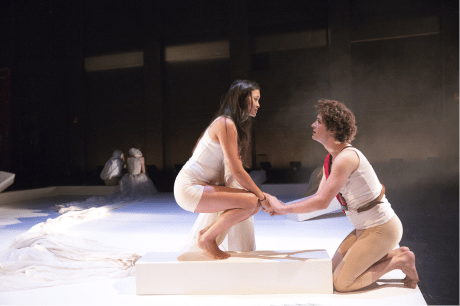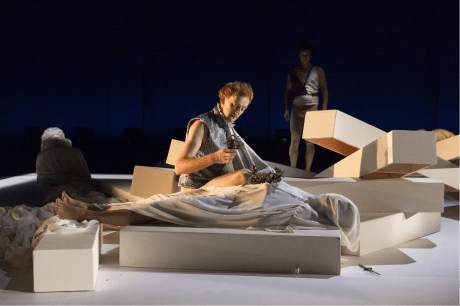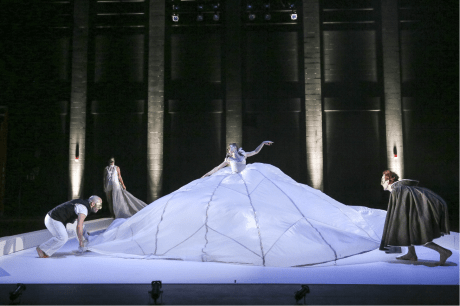It is a body-felt joy of the senses to hear and see Aquila Theatre’s new production of Romeo and Juliet, directed and adapted by Desiree Sanchez, which played at George Mason University’s Center for the Arts last night. The story is so well known that there’s no need to rehash it here. The pertinent question is, what is distinct about this production, what is its particular quality, and virtue?

First, some basics: Shakespeare’s eight plus actors are cut down to five, the original seventeen roles to eight. The story is condensed, focused, and chiseled away at until it stands out in uncluttered relief. Capulet is gone, and some of his lines go to his wife, Lady Capulet – Juliet’s mother. This transfer is not simply a matter of economy, but of design. Sanchez wanted to highlight the mother-daughter relationship, which here emerges as a stark, lambent theme of the play.
Sanchez selected the five actors from a large pool of highly-competitive applicants, she said at a pre-show Q & A, and the wisdom of her casting choices becomes evident in the production. The actors speak beautifully, move beautifully, thoroughly embody their parts each in his or her own stunning way, and attain in ensemble a level of choreographed precision that moves by virtue of its lucid, revelatory grace.

The show is excellent point-by-point, yet its particular virtue lies not in these individual excellences but rather in their cohesion as an undivided whole. It is the architecture of the piece that is the chief thing, the way everything is arranged to create a unified effect moment to moment, one that is constantly shifting; these shifting effects mesmerize – and at times, astound.
The set, conceived by Sanchez late in the design process, well into rehearsal, was constructed at great speed with the help of Robert Ingraham. It consists of a number of wooden blocks of varying sizes, but all massive, which can be moved about and arranged in various configurations to meet the needs of each scene.
Company composer Joe Louis Robertson has written a score that is modern and urban in tone, and which integrates into itself atmospheric pieces by Brian Eno and Gabrielle Roth and the Mirrors; it plays intermittently, unobtrusively and, where it enters, harmonizes with the action and corresponds in tone with the feeling emanating from the stage.

Costume Designer Clare Amos has created visually striking and classically elegant costumes, a memorable fusion somehow vaguely Elizabethan, vaguely of Renaissance Italy, suspiciously modern yet with hints of Mediterranean antique. Overall, they seem surreal, cloud-like, woven – one supposes – from a matter that is the stuff of faerie and dreams. Mostly whitish, the few splashes of brilliant color – such as Romeo’s red cape – strike directly on the eye. Other colors, such as a light green cape, come out in a gentler, subtler way. Coupled with the lighting effects, the costumes double as the scenery.
The lighting design by Alberto Segarra, who is also the technical director, is likewise elegant, atmospheric, and visually striking. For the most part dimly lit, the stage brightens up here and there to set the mood and irradiate the action. At some points we see mist, a crepuscular-blue haze, a light-circle moon, and other eerie, picturesque effects.
As this is a piece of stage sculpture and balletic movement, Segarra makes generous use of side lighting to bring out dimensionalities of form and highlight the structural fluidity of stage-space, the dynamic and static potentials of which Director Sanchez makes full use throughout the production.
Credit also goes to Stage Manager/Assistant Director Preece Killick, Production Manager Gus Jacobson, Assistant Technical Director Chase Duhe, and Assistant Stage Manager Brionna Ingraham. James McDaniel, the costume technician, has in addition designed the marvelous “Capulet Dress,” fit for an Elizabethan faerie queen and the best costume in show.
I mentioned that the actors move and speak beautifully – this is not a casual remark, but a vivid fact of the spectators’ – and auditors’ – experience. I could not have asked for higher music, a diction more crisp and audible, or lines of verse more resonant with emotion that strikes the bell of authenticity and nature. The movements are graceful, adept, and controlled; the marble poses – stone still, as perfect and alive as renaissance statues. Credit here must go to the actors and to the director equally.
The show flows beautifully. Locations, scenes, and affective styles transition into and out of each other with seamless elegance, and the action never falters. What the revised script loses in variety it gains in poignant clarity. The emotions come full out, are both profound and believable.
This is a very real and very serious production, full of shadows and chiaroscuro light. Romeo and Juliet step onstage as more than horny teenagers or conventionally doomed lovers. They are two young persons come together burning ardently within the flame of life, snuffed out in heedless misunderstanding.
Michael Rivers’ Romeo shines as a bright fay Apollo and curly-haired, red-blooded Italian youth. Kirsten Foster’s Juliet is impassioned, adolescent, and beautiful. Both are heady, bursting, vivid, florid, alive. Peter Groom is stately and comic as Paris, the Nurse, and Tybalt, picturesque in every way; Hemi Yeroham’s Mercutio is funny, earthy, endearing, and his Friar Laurence endearingly captures the generosity and naïveté of the gentle, meddling priest. Finally, Lauren O’Dair pulls off – with great adroitness – the difficult role of a perfectly poised ice queen with her weeping heart of fire (Lady Capulet).
Two scenes stand out particularly in my mind. First is the balcony scene, perhaps because of its iconic place in popular culture. Here the balcony is not upstage and center, but a platform moved stage right, one piece set upright for Foster to lean on. The moon shines luminous against the far wall, and Juliet mutters her desperate plea as Romeo attends, to the side and figuratively below. He climbs up the balcony to embrace her, hopping laterally from set-block to set-block to go higher and higher, startling his amour as he approaches her from behind.
The second is the equally famous death scene. We see Romeo downstage right, expounding on his hopes for the future with Juliet, as directly behind him she takes the draught that renders her lifeless still. A few charged moments later, we have two deaths, then the final tableaux, with Lady Capulet holding Juliet astride her bier in the stage-block mausoleum, as she tenderly joins her daughter’s hand to the hand of Romeo. It’s arresting, and we cut to black.
There is a sage lightness, an esprit de liberté, that pervades most of Shakespeare, as it does the best of his actual or near contemporaries, Cervantes, Montaigne, Erasmus and More. That is in clear evidence here, but I also found the sadness of Shakespeare, which is to be seen especially in the later plays. The fact that Romeo and Juliet dates from the 1590’s suggests to me that Aquila theater has made something that differs in spirit from the busier, more crowded original. That’s not a bad thing, for spirit is a subtle element no matter can hold – what this production does is remind us that poetry beautifully spoken is spiritual not only in proceeding through breath (spiritus) but in proceeding from the soul of life (psyche, nefesh), truly inspired.
Aquila Theater’s Shakespeare is not light fluff. It may have too much gravity and darkness for some tastes, but it brings out poetry the way a more prosaic version wouldn’t, and a different sort of poetry than a more standard approach would.
We have here a remarkable fusion of design, text, and performance, of consciousness, scenery, sound, light, space, meaning, and movement.
This is Romeo and Juliet as high tragedy, a balletic dream sculpted in moonstone ghost; a lighted candle melting in wax from mise-en-scène to mise-en-scène; a grandeur of poetry and high art. It is beautiful and disturbing. Deeply moving, without a trace of sentimentality.
Running Time: Two and a half hours, with one 15-minute intermission.
Romeo and Juliet played for one night only on Sunday, October 11, 2o15 at Aquila Theatre, performing at Performing Arts Center at George Mason University – 4373 Mason Pond Drive, in Fairfax, VA. Check Aquila Theatre’s website for their upcoming tour dates. For upcoming events at The Center for the Arts, check their schedule of events.


![Aquila - Romeo&Juliet_Web_728x90[2]](https://dctheaterarts.org/wp-content/uploads/2015/09/Aquila-RomeoJuliet_Web_728x902.jpg)


